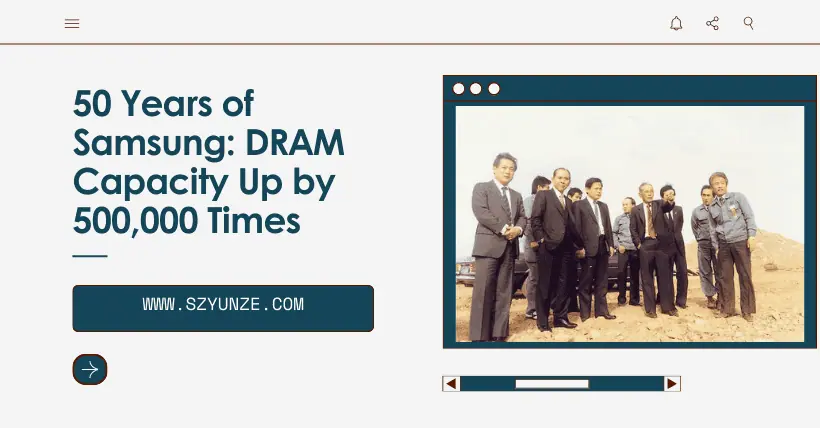Samsung Electronics is about to celebrate the 50th anniversary of its entry into the semiconductor business.
The acquisition of Korea Semiconductor, the first semiconductor wafer processing company in Korea, became the cornerstone of Samsung Electronics’ current success.
Over the past 50 years, Samsung Electronics has achieved remarkable growth, becoming the world’s largest memory company.
However, recently, it has faced a crisis, with the HBM market performing poorly.
Samsung Electronics has maintained its position as the top memory semiconductor company through bold investments and continuous research and development, demonstrating exceptional competitiveness and achieving significant growth, including a 500,000-fold increase in DRAM capacity.
However, due to the recent global economic downturn and sluggish semiconductor performance, both internal and external crises are increasing within Samsung Electronics.
As a result, Samsung Electronics is actively seeking ways to overcome the complex crisis and is taking measures to restore its fundamental competitiveness.
Samsung Electronics’ semiconductor business began on December 6, 1974, when the late Chairman Lee Kun-hee, then a director of a Samsung affiliate, invested personal funds to acquire Korea Semiconductor.
Korea Semiconductor was the first semiconductor wafer processing and production company in Korea and was on the brink of bankruptcy at the time.
At the beginning, Samsung Electronics’ semiconductor business mainly produced simple chips for watches and televisions. The turning point came in 1983 with the so-called “Tokyo Declaration.”
In February 1983, the late founder of Samsung, Chairman Lee Byung-chul, officially announced the company’s entry into the domestic and international semiconductor market through the “Tokyo Declaration,” and began construction of the Giheung factory, which typically required more than 18 months to complete, but was finished in just six months.
At the time, no one expected success, but by November 1983, just six months after product development began, Samsung independently developed the entire semiconductor process technology, including 64Kb DRAM processing, testing, and assembly technologies, and became a global leader.
Korea became the third country in the world, after the United States and Japan, to successfully develop advanced semiconductors.
In November 1988, the semiconductor business officially began with the merger of Samsung Semiconductor and Communication Co., Ltd.
Before 1989, Samsung ranked fourth globally, after Japan’s Toshiba, NEC, and the United States’ Texas Instruments. By 1990, it was closing in on Toshiba (14.7%) with a market share of 12.9%, and in 1992, Samsung surpassed Toshiba (12.8%) to claim the top spot in the global DRAM market with a share of 13.5%.
1992 was also a historic year, as Samsung developed the world’s first 64Mb DRAM.
Since officially entering the semiconductor business and developing 64Kb DRAM, integration density grew 1,000 times in just 9 years.
By 1993, Samsung had become the global leader in the memory semiconductor industry, a position it has maintained for over 30 years.
In 1994, Samsung developed the world’s first 256Mb DRAM, and in 2002, it became the first to mass-produce NAND flash memory. In 2011, it was the first to mass-produce 20nm DRAM and the first generation of V-NAND.
In 2013, Samsung introduced 3D vertical architecture, and in 2016, it launched the world’s first 10nm NAND, setting a record for high-end DRAM mass production.
In 2022, Samsung achieved the world’s first commercialization of the next-generation Gate-All-Around (GAA) 3-nanometer process, and in April 2023, it successfully mass-produced the industry’s first 1Tb TLC 9th-generation V-NAND.
In September 2023, the largest capacity 32Gb DDR5 DRAM was developed and released, which is 500,000 times the capacity of the 64Kb DRAM from 1983.
Samsung Electronics’ semiconductor department’s sales were just 200 million KRW in 1975, surpassed 1 billion KRW in 1986, and reached 1 trillion KRW by 1991.
In 2022, the department achieved its highest-ever sales, reaching 98 trillion KRW, a 36-fold increase over the 2.7 trillion KRW in 1993 when it first became the leader in the memory semiconductor field.
This year, semiconductor sales are expected to surpass 100 trillion KRW for the first time in history.
In 2022, operating profit from semiconductors reached 24 trillion KRW, which is more than 7,000 times higher than in 1983 when the “Tokyo Declaration” was made, and 31 times higher than in 1993.
Related:

Disclaimer:
- This channel does not make any representations or warranties regarding the availability, accuracy, timeliness, effectiveness, or completeness of any information posted. It hereby disclaims any liability or consequences arising from the use of the information.
- This channel is non-commercial and non-profit. The re-posted content does not signify endorsement of its views or responsibility for its authenticity. It does not intend to constitute any other guidance. This channel is not liable for any inaccuracies or errors in the re-posted or published information, directly or indirectly.
- Some data, materials, text, images, etc., used in this channel are sourced from the internet, and all reposts are duly credited to their sources. If you discover any work that infringes on your intellectual property rights or personal legal interests, please contact us, and we will promptly modify or remove it.
- Cover Image: In 1983, Chairman Lee Byung-chul of Samsung Semiconductor Communication, Chairman Lee Kun-hee in his younger days, and Chairman Hong Jin-ki of JoongAng Ilbo are inspecting the construction site of the Giheung plant.



